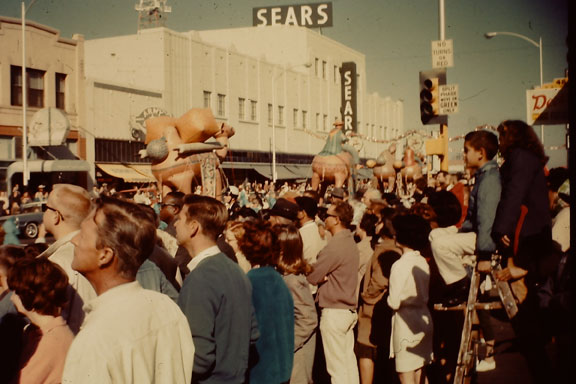With a resounding crash of
martial music from two military bands, the muffled sounds of horse’s
hooves, the colorful stream of cowboys, cowgirls and Indians, La Fiesta
de los Vaqueros, Tucson’s first annual rodeo will open this morning when
the parade starts on West Congress Street at 10:30 o’clock.
Contestants and visitors
from all parts of the country are filling the city to capacity; and cars
are arriving each hour, bringing people who are either taking part or
wishing to see the rodeo at Santa Catalina Field. Under the charge of
the parade committee, with Cleon Sellers, President of the Tucson Rotary
Club as Chairman, the parade will be formed on West Congress Street
near the El Paso and Southwestern Depot station.
The first Tucson Rodeo Parade
was established to advertise and draw spectators to the rodeo to be
held immediately following the parade. It featured two military bands,
mounted cowboys, cowgirls, Native Americans, mounted police and the
University of Arizona polo team. All cowboys participating in the rodeo
were required to participate.
Local businessmen donated
cash and merchandise prizes. The prize list included Most Typical Cowboy
and Cowgirl, Prettiest Horse, Biggest Hat, Finest Saddle and Bridle,
Most Comical Costume, Fattest and Skinniest Horse and Best Decorated
Automobile. The first parade did not claim to be non-motorized as
today’s event is.
The first rodeo and parade
brought out the best in Tucson nightlife. Cecil B. DeMille’s “The
Golden Bed” was playing at the Rialto Theater and at the Opera House,
Thomas Meigan starred in “Tongues of Flame.”
The rodeo dance at the Santa
Rita Hotel the night before was well attended by tourists, cowboys,
cowgirls and local society members. Sleeping accommodations were
scarce, and pleas went out to hotels and private homes to spare a
bedroom. Taxi rides from downtown to the rodeo grounds were set at $.25
for a party of four.
Quite a beginning for what has become one of the world’s longest non-motorized parades.
Through the decades, the
Tucson Rodeo Parade has become one of the finest and best-loved
traditions in southern Arizona. The parade has become so
established that most local school districts close classes for the
Thursday and Friday of Rodeo week.
Generations of Tucsonans
have ridden or marched in the annual parade, and some families wouldn’t
think of missing the yearly festivities.
A consortium of local civic groups such as the Kiwanis, Rotary, Lions and Engineers Clubs organized the first two parades. Beginning
in 1927, the American Legion Post #7, with the backing of the Chamber
of Commerce, ran the parade through 1932, when the Tucson Rodeo Parade
Committee was formed, mostly comprised of local businessmen and
community leaders.
Through the years such
recognizable names as Roy Drachman, J.C. Kinney, Paul Grimes, Pete
Waggoner, Bill West, Bruce Knapp, George Chambers, Bill Breck, Bucky
Steele, Bill O’Riley, Frank Roe and Alex Jacome have served on the Tucson Rodeo Parade Committee.
Today, the Parade Committee
consists of 35 active members, with three associate members, and
numerous advisory members who lend their past expertise to the group.
The Committee tends to all aspects of planning for the parade from
accepting applications to coordinating with the numerous City of Tucson
departments that assist with the parade.
They also operate the Tucson Rodeo Parade Museum,
located at the Tucson Rodeo Grounds. The museum houses many displays of
western memorabilia and the Committee’s collection of more than 125
wagons, buggies, coaches and other horse-drawn equipment.
 Many celebrities have graced the streets of Tucson in the Rodeo Parade through the years.
Many celebrities have graced the streets of Tucson in the Rodeo Parade through the years.
Old Tucson hosted many
Westerns and movie stars such as Gary Cooper, Robert Taylor, William
Boyd, Gene Autry, Janet Leigh, Jimmy Stewart, Rex Allen, Michael Landon,
Lief Erickson, Cameron Mitchell, Debbie Reynolds and Tony Curtis, who
all joined in the parade.
Tucson Rodeo Grand Marshals
have included U.S. Ambassador Raul Castro, Governor Rose Mofford, Mayor
Lew Murphy, UA basketball coach Lute Olson, actors Ben Johnson and Don
Collier, rodeo performers Chuck Henson, Hadley Barrett, Charles Sampson,
and Larry Mahan and The Sons of the Pioneers.
The parade took place in
downtown Tucson until 1991 when, for safety reasons, the parade was
shifted to the streets around the Tucson Rodeo Grounds. Better
participant and spectator parking, wider streets, and less congestion
created a safer, more spectator-friendly parade route.
The Tucson Rodeo Parade is
truly a tradition in Tucson. It has become the largest single spectator
event in Tucson, with average attendance reaching upwards of 150,000.
Pretty amazing when you think that the population of Tucson in 1925 was
roughly one-fifth that number.
Photo: Tucson Rodeo Parade in downtown Tucson, Arizona 1963. Photo by Bertram Zucker.